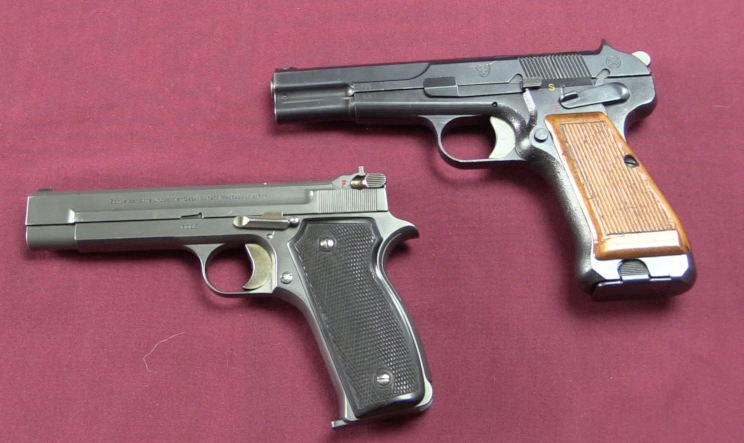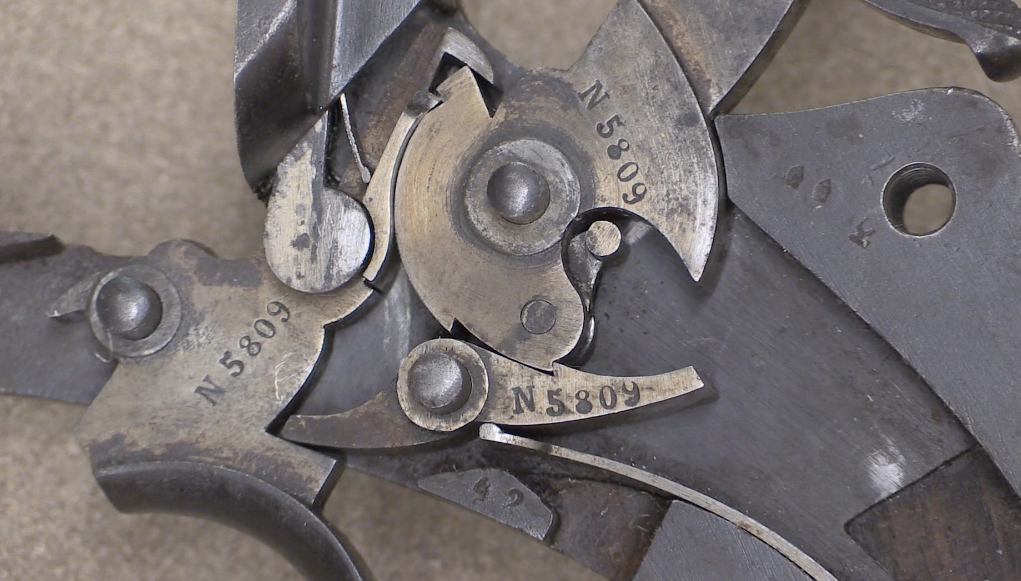Once it became apparent that the MAS-36 was going to be used in a substantial amount of frontline combat (to the contrary of its intended role as a reserve or secondary rifle), it became important to provide it with grenade launching capability. The French military really liked rifle grenades as a way to have explosive support firepower always available with the frontline infantry, without needing to call for specialized units like mortar crews.
After various experiments with clamp-on launchers (like and including the WW1 VB launcher), the LG48 (lance grenade, or grenade throwing) rifle was adopted in 1948. It used the same basic projectile as the Mle 1937 50mm light mortar, but with a new tail assembly fitted which allowed it to slide over the muzzle of a MAS-36 rifle. The LG48 rifle was essentially just a MAS-36 with a new nosecap assembly which included a simple grenade sight and a range-setting adjustable sleeve over the barrel.
The LG48 pattern rifles were made both brand new in the St Etienne factory and also supplied as conversion kits to be applied in the field. Neither type ever received new or special markings to identify their grenade launching status. The Mle 1948 grenades and the LG48 rifles were declared obsolete in 1968, as the French had switched to the NATO standard type of rifle grenades in the early 1950s. In 1968 the existing rifles were ordered to be retrofitted back to standard MAS-36 pattern, and their lack of special markings makes those retrofitted rifles virtually indistinguishable from original MAS-36 rifles. The surviving examples, like the one in this video, are almost all from nations which received the rifles as military aid from France and were not subject tot he French retrofitting order (this particular rifle was imported as part of a batch from Lebanon in the 1990s).
Get the shirt here:





And nobody considered the issue of over-stressing the barrel or stock. As fun as it would be to have the entire platoon play grenade spam with the other team serving as the intended victims, this may provoke retaliation by proper mortar fire or heavy artillery, to say nothing of annoying a medium tank with a very trigger-happy gunner…
“say nothing of annoying a medium tank with a very trigger-happy gunner”
I am not sure about that particular modern, but generally grenade-launcher rifles can be used together with HEAT projectiles giving armor-piercing ability.
Korean War-era Belgian-made ENERGA: https://en.wikipedia.org/wiki/ENERGA_anti-tank_rifle_grenade
or using official name Anti-tank Grenade, No. 94 (ENERGA)
it has ability to penetrate 200 mm armor, so it should be enough against non-heavy tank of that period.
“nobody considered the issue of over-stressing the barrel or stock”
Is ballistic (muzzle energy) of grenade heavy enough to have any meaningful effect? So called 22 mm grenades: https://en.wikipedia.org/wiki/22_mm_grenade
seems to be used widely through 20th century, so it seems that side-effects (if present) were acceptable.
As Ian Hogg related in Grenades and Mortars
https://www.amazon.com/Grenades-Mortars-Weapons-Book-no/dp/0345237234
The problems with grenade launching from a rifle are twofold.
First, a rodded grenade causes a gas “check” pressure peak where its rod ends inside the barrel when it’s fired. This inevitably results in a ring-bulge in the barrel, and sooner or later the barrel will split open or even burst at that point. The cure for this is the discharger cup, or else the grenade launcher with a grenade tail that fits over the outside, much like a spigot mortar. The gas “check” then occurs at the muzzle, where it does no harm to the barrel.
The other problem is more insoluble. The mass of a grenade is many times the mass of even the heaviest bullet. As per Newton’s Third law of Motion, firing the heavy weight of a grenade one way causes a proportionately heavy recoil the other way, much heavier than the rifle was originally designed for. This excessive force tends to split the stock, bend or break bedding-bolts, overstress and even fracture the receiver/barrel mate-up, and just generally batter the rifle to bits in relatively short order.
During World War One, it was customary to reinforce the rifle’s stock and etc. with wire-wound bindings to prevent it from coming apart under this sort of mistreatment at least long enough to win the war. The British Army went so far as to have an officially-issued reinforced grenade launching version of the SMLE, called the EY rifle;
http://www.empirearms.com/60828H.jpg
As you can see from the inscription, this variant showed up in WW2 as well, still doing the same job, i.e., flinging No. 36M Mills Bombs into the enemy’s dugouts and etc.
Incidentally, no one is quite sure what “EY” stood for originally, and the debate over its exact meaning continues to this day.
Occasionally, these “reinforced” rifles show up in the shops and at gun shows. They make nice curios, but firing them with ball ammunition is not recommended. Their barrel and action bedding is a bit dicey, to say the least, less from the state of the barreled action than that of the stock.
cheers
eon
did the launcher take a special blank cartridge?
Yes. All French rifle grenades of the era required a separate blank cartridge. Later 22mm grenades had the cartridge stored in a plug in the base of the grenade (the plug was obviously discarded). The French did not adopt bullet trap rifle grenades until the late 1970’s with the introduction of the FAMAS.
I have two questions:
Did the soldier launching a grenade have to carry, and remember to load, a blank cartridge (I always guessed having grunts under stress forgetting, and firing a bullet through a grenade, was the reason rifle grenades were never common)?
Did the Free French ever use the MAS 36? My understanding is that all French (and other Allied forces fighting with British or American forces) were equipped with either British or American weapons, or they were simply were not put in any front line.
But rifle grenades WERE very common… US used them until early ’60s and whole NATO used them much longer, British until about 2004-5-6 back, Germans until ’80s, Belgians still use them, Norvegians until ’90s etc. France still uses them and one of requirements for their new rifle was that it should be able to take a steady diet of RGs.
Non-NATO Europe uses them also, Yugoslavia used NATO-standard 22mm launcher.
Even in WP some countries used them – Albania, Poland and Hungary.
Outside Europe India and Pakistan used them (India still uses them) as did South Korea and Israel. Plus many many more.
“France”
Article: https://warisboring.com/the-french-army-has-a-passion-for-rifle-grenades/
with photos and videos showing French rifle grenades. It has also summary of history of grenade launching. Generally rifle grenades declined in use after development of under-barrel grenade launchers and various portable anti-tank weapons (recoilless rifle, rocket launcher).
Another competitor to rifle grenades were light-weight mortars
http://www.angelfire.com/art/enchanter/mortars.html
“firing a bullet through a grenade, was the reason rifle grenades were never common”
There existed some solutions allowing usage of normal (live) round for launching grenade. One example is French Viven-Bessières commonly known under acronyme VB: https://en.wikipedia.org/wiki/VB_Rifle_Grenade
Grenade has internal cube allowing passage of bullet.
Other solution which allowed usage of live round for throwing grenade and interestingly employed standard grenade (without need to have tube drilled inside it) was WWII-era Japanese Type 100 Grenade Launcher
http://www.imfdb.org/wiki/Type_100_Grenade_Launcher
it function similarly to gas-operated weapons, with difference that gas retrieved is used to throw grenade rather than operate weapon
Modern rifle grenades with 22mm tail booms for 5.56 x 45mm rifles often come in “regular” and “bullet trap” versions. The regular version must be fired with a special blank cartridge.
The “bullet trap” type has a resilient “plug” or “cushion” in a special hardened steel “socket” inside the tail to stop the bullet from going through the grenade’s filling (and probably setting it off). Instead, the bullet’s kinetic energy is used to throw the grenade downrange, rather like “knocking away” a ball in croquet.
Bullet trap grenades in NATO service customarily have the letters “BT” in their designation. Note that generally, the BT version of any rifle grenade will have about 15-20% less effective range than the blank-fired version.
And NB; Confusing the two types can be extremely unhealthy for the operator.
cheers
eon
The first French soldiers who rallied around DeGaulle in London in the aftermath of France’s surrender were primarily armed with the MAS 36. This was because the core of these original Free French were the 13th Demi-Brigade of the Foreign Legion(13th DBLE)a provisional half sized brigade made up of Foreign Legion volunteers which had been created specifically for the Norway Expedition. The Norway Expedition was formed of battalions of France’s elite light infantry like the Legion and the Alpine Mountaineer/ski troops. As they were formed up, the MAS 36 was issued to the infantrymen with only the ammo bearers(for the FM 24/29)retaining the 8x50mm Berthier carbines as personal defense weapons. This allowed the bulk of ammo transport to be dedicated to the 7.5 MAS 29C cartridges for the infantry squads.
The Free French used their MAS 36s as long as they could find the ammo for them. In the infantry squad the automatic rifle, the FM 24/29, was the primary striking power so supplying its ammo was paramount. Thus, before and after the liberation of French North Africa, the Free French exchanged their MAS 36s for first British then American rifles so that all available 7.5 ammo could be issued to the FM. Contrary to what you see in some movies and Call Of Duty:Big Red One, the Vichy French North African garrison wasn’t lavishly equipped with FMs or MAS 36s, so the 7.5 ammo shortage wasn’t alleviated by too much. This saw the almost complete retirement of the MAS 36 and the eventual retirement of the FM during the Italian campaign. By the time of D-Day US weapons and uniforms were the norm(except for the commando and airborne units equipped by the British).
The MAS 36 and the FM would be returned to the fray when French resistance fighters would join with the former Vichy soldiers after D-Day. The small single regiment Armistice Army had been primarily equipped with MAS 36s which they used alongside the FFI Maquis. The Maquis who had MAS 36s ranged from former soldiers, who had refused to surrender in 1940 and taken their weapons into the bush, to those hastily equipped by the surrendered garrisons of the Atlantic Wall who had been equipped with French weapons.
The largest use of the MAS 36 by the French between 1940 and 1945 was after September 1944 when the combined Free French and FFI army numbered 400,000. Everyone of the 200,000+ MAS 36s that had been built before and after 1940 and were still in French hands were pressed into service as DeGaulle tried to form his dream army of 36 divisions. They joined the morass of rifle types that often mixed in the same squad regardless of ammo supply.
The MAS 36 finished the war in the hands of French troops who varied from the elite troops of the Alpine troops and Shock Commandoes to the rather wretched ad hoc FFI units that were stationed around the German held Atlantic pockets(as more of warning system than a besieging army). Of course, this was nothing as compared to the amount of use it would get in the next 15 years of France’s misguided attempts to hang on to its colonies.
Yes! The core of the Free French that first organized in London under DeGaulle were 1300 Foreign Legionnaires from the 13th provisional brigade formed up for the Norway Expedition. This brigade’s riflemen were all equipped with the MAS 36 when they were organized in France.
In the African campaigns that followed, the Free French used the MAS 36 and its accompanying FM 24/29 LMG as long as they had ammunition for them. The MAS 36 was practically unknown in the French colonies that the Allies but the FM 24/29 was standard in some of the Vichy garrisons, so they were able to replenish their supply of 7.5mm ammo from they captured them.
The Free French inevitably had to retire the 7.5mm weapons and accept american and british weapons by the end of the african campaigns. But when the Liberation began MAS 36s taken from Vichy and German stores were quickly issued to the newly resurrected new French army, alongside those in the hands of existing FFI.
I’ve been watching the Burns and Novick film “The Vietnam War” and it includes a lot of footage from the early days (1958 and on) and there are several clips/stills where you can see rifle grenades on various rifles including M-1 Garands (which were used extensively by the ARVN and then captured and used by the NLF) and various bolt-action rifles. (B y the way you can watch it in english, spanish, or vietnamese http://www.pbs.org/kenburns/the-vietnam-war/home/)